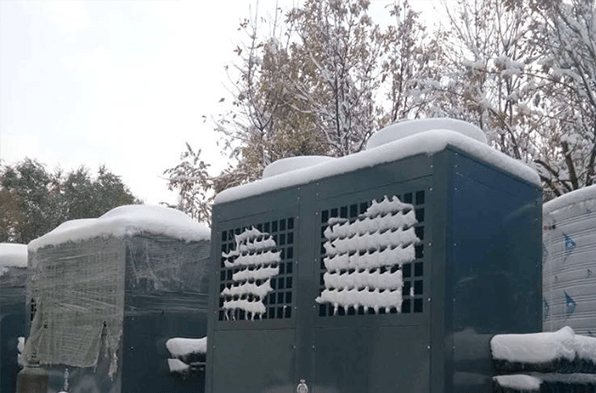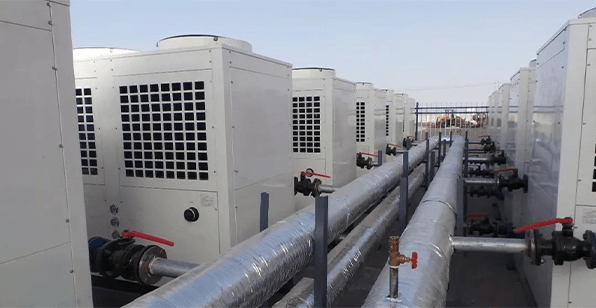
Figure 1: Heat pump unit.
Heat pumps are a popular and energy-efficient choice for heating and cooling homes in many parts of the world. One of the key features that make heat pumps so efficient is their ability to transfer heat from one place to another.
However, during the colder months, frost can accumulate on the outdoor unit's coils, which can reduce the heat pump's efficiency. To combat this issue, heat pumps are equipped with a defrost cycle. In this article, we'll explore the heat pump defrost cycle in more detail.
1. What is a Heat Pump Defrost Cycle?
A heat pump defrost cycle is a process that occurs automatically when the outdoor temperature drops below freezing. During this cycle, the heat pump temporarily switches from heating mode to cooling mode to remove any frost buildup on the outdoor unit.
The defrost cycle of a heat pump typically lasts between 5 and 15 minutes and occurs every hour or so, depending on the specific heat pump model and outdoor conditions.

Figure 2: Heat pump defrost cycle diagram.
2. How Does the Heat Pump Defrost Cycle Work?
The heat pump defrost cycle is initiated by a sensor located on the outdoor unit called a defrost thermostat. When the defrost thermostat senses that the outdoor coil has become too cold due to frost buildup, it sends a signal to the heat pump control board to start the defrost cycle.
During the defrost cycle, the reversing valve reverses the flow of refrigerant, switching the heat pump from heating mode to cooling mode and causing the outdoor coil to heat up. The fan on the outdoor unit shuts off, allowing the coil to warm up without blowing cold air into your home. The heat from the outdoor coil melts the frost buildup, which drips off the coil and onto the ground.
Once the defrost cycle is complete, the heat pump returns to heating mode, and the fan on the outdoor unit turns back on. The heat pump continues to operate normally until the defrost thermostat detects another frost buildup and initiates another defrost cycle.

Figure 3: Air source heat pump frosting.
3. Why is the Heat Pump Defrost Cycle Important?
The heat pump defrost cycle is essential for maintaining the efficiency and longevity of your heat pump. When frost builds up on the outdoor coil, it reduces the airflow through the coil, which can cause your heat pump to work harder and use more energy to maintain the desired indoor temperature. This can lead to higher energy bills and put unnecessary strain on your heat pump's components.
If left unchecked, frost buildup can also cause the outdoor coil to freeze completely, which can damage the compressor and other critical components of your heat pump. The defrost cycle of the heat pump helps prevent this from happening by removing any frost buildup before it becomes a problem.
4. When Does the Defrost Cycle Occur? (What Triggers Heat Pump Defrost Cycle?)
The defrost cycle is typically initiated when the heat pump detects frost or ice buildup on the outdoor coil. Several factors can influence when the defrost cycle occurs, including:
● Outdoor air temperature: Colder temperatures increase the likelihood of frost and ice forming on the coil.
● Humidity: Higher humidity levels can lead to more frost and ice buildup.
● System runtime: The longer the heat pump operates, the more likely it is to accumulate frost and ice.
Most modern heat pumps use sensors and control algorithms to determine the optimal time for the defrost cycle. Some systems initiate the defrost cycle based on a timer, while others use temperature and pressure sensors to detect when the outdoor coil's performance is being impacted by frost and ice.

Figure 4: Snow covered air source heat pump unit.
5. How Long Does the Defrost Cycle Last? (How Long Should It Take a Heat Pump to Defrost?)
The duration of the defrost cycle can vary depending on the heat pump model and the amount of frost and ice buildup. On average, the defrost cycle lasts between 5 and 15 minutes.
During this time, the heat pump is not providing heat to your home, which is why some systems activate an auxiliary heat source during the defrost cycle.
6. Is the Defrost Cycle Noisy?
It is normal for the heat pump to make some noise during the defrost cycle, as the system switches from heating to cooling mode and back again. You may hear the outdoor unit's fan stop, and you might notice a whooshing sound as the refrigerant changes direction. These noises are normal and should not be a cause for concern.
7. How to Tell if Your Heat Pump is Defrosting Properly

Figure 5: Snow buildup on the outdoor units.
If you suspect that your heat pump is not defrosting properly, there are a few signs to look out for:
● Ice buildup on the outdoor unit: If you notice ice buildup on the outdoor unit that doesn't melt away during a defrost cycle, it could be a sign that your heat pump is not defrosting properly.
● Cold air blowing from vents: During the defrost cycle, the fan on the outdoor unit should turn off, and cold air should not blow from your vents. If you feel cold air coming from your vents during a defrost cycle, it could indicate a problem with the defrost control or sensor.
● Short cycling: If your heat pump is short cycling (turning on and off frequently), it could be a sign that it is not defrosting properly. Short cycling can occur when the outdoor coil becomes too cold and causes the heat pump to shut off prematurely.
If you notice any of these signs, it's important to have your heat pump inspected by a qualified HVAC technician. They can diagnose the issue and make any necessary repairs to ensure that your heat pump is functioning correctly.
8. Tips for Maintaining Your Heat Pump in Cold Weather
To ensure your heat pump operates efficiently during the colder months, follow these tips:
● Keep the outdoor unit clear of snow, ice, and debris. This will help prevent frost and ice buildup and allow for proper airflow.
● Schedule regular maintenance with a professional technician to inspect and service your heat pump. This will help identify any issues early and ensure optimal performance.
● If possible, install a heat pump with a demand defrost feature, which can help minimize energy consumption during the defrost cycle.
In conclusion, the heat pump defrost cycle is a critical feature that helps maintain the efficiency and effectiveness of your heat pump during cold weather. By understanding how the defrost cycle works and taking steps to maintain your heat pump, you can enjoy comfortable indoor temperatures and lower energy bills, even in the coldest months.

Figure 6: Check heat pumps.
9. FAQs
9.1 Do All Heat Pumps Have a Defrost Cycle?
Most modern heat pumps have a defrost cycle. The defrost cycle is an essential feature that helps maintain the efficiency and effectiveness of the heat pump during colder months.
When the outdoor temperature drops below freezing, frost or ice can accumulate on the outdoor unit's coils, which can reduce the heat pump's efficiency. The defrost cycle automatically switches the heat pump from heating mode to cooling mode to remove any frost buildup on the outdoor unit.
However, some older or less sophisticated heat pump models may not have a defrost cycle, so it's essential to check the specifications before purchasing a heat pump.
9.2 How Often Does Defrost Cycle Run on Heat Pump?
The frequency of the defrost cycle on a heat pump can vary depending on several factors, such as outdoor temperature, humidity, and system runtime. Typically, the defrost cycle lasts between 5 and 15 minutes and occurs every hour or so, depending on the specific heat pump model and outdoor conditions.

Figure 7: Clean heat pump units.
9.3 What Happens When a Heat Pump Goes into Defrost Mode?
When a heat pump goes into defrost mode, it switches from heating mode to cooling mode to remove any frost buildup on the outdoor unit's coils.
When heat pump switches to cooling mode,
● The outdoor coil heats up, melting the frost and ice buildup.
● The heat pump may also activate an auxiliary heat source, such as electric resistance heaters, to provide heating to the home during the defrost cycle.
● Once the frost and ice have melted, the heat pump returns to heating mode.
9.4 Heat Pump Defrost Cycle too Often?
If your heat pump is going into defrost mode too often, it could indicate a problem with the defrost control or thermostat. Several factors can influence how often the defrost cycle runs, including outdoor temperature, humidity, and system runtime.
However, if you notice that your heat pump is defrosting more frequently than usual, it may be a sign that something is not working correctly. This can lead to higher energy bills and put unnecessary strain on your heat pump's components. It's essential to have your heat pump inspected by a qualified HVAC technician to diagnose the issue and make any necessary repairs.
Related Info
Why is My Heat Pump Freezing up (Causes, Prevention, and Solutions)Why is My Heat Pump Freezing Up in Winter (Causes, Prevention, and Solutions)
Step-by-Step Guide: How to Fix Heat Pump Freezing Up in Winter
Why is My Heat Pump Freezing Up in Summer: Common Causes and Maintenance Tips
Heat Pump Making Loud Noise in Cold Weather: Causes and Solutions


